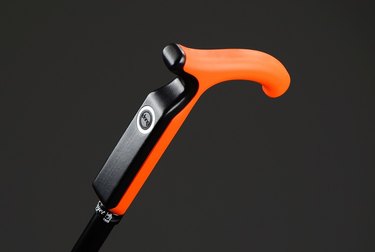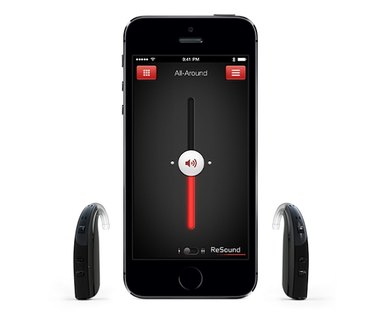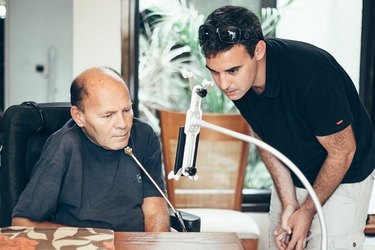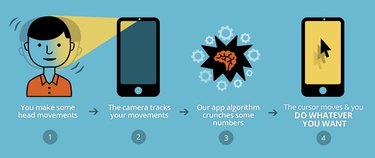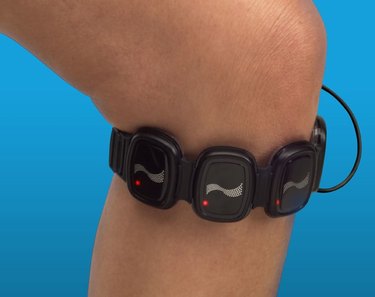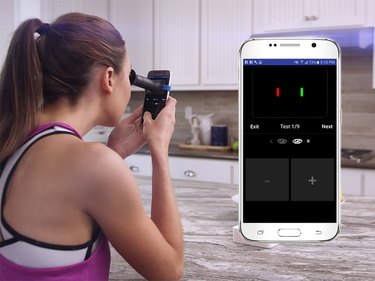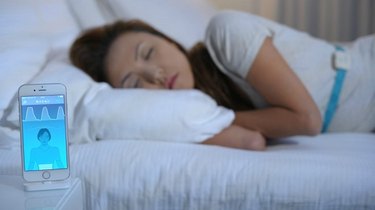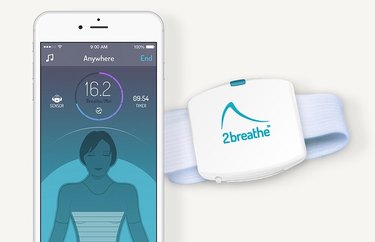Pokemon Go and Candy Crush may be fine as far as they go, but technology is at its best when it helps better the human condition. And 2017 is emerging as the year for tech which come to the aid those with disabilities. We've rounded up a few of the most intriguing assistive technologies--as well as a couple of products just meant to improve life for the rest of us.
The Smartcane
Video of the Day
If you're worried about a loved one who's getting on in years, the smart cane may help ease your concerns. It looks pretty classy; it's designed by a famous French walking stick company called Fayet, and it includes some smart tech from a company called Dring.
The end result is the Smartcane. It's designed to learn its owner's habits to keep you informed about his or her health. When it detects unusual activity, it sends an alert without requiring any additional action. For example, if you have an elderly parent who misses his or her morning walk, the designated caregiver will receive an alert. Likewise, if the cane falls over, a built-in accelerometer and gyroscope knows it. An alert is sent out so you can check up to make sure that it wasn't just the cane that fell.
The Smartcane doesn't just detect a single event, like a fall or a missed walk. It also identifies changes over time, like lower activity each day, or if the user is getting up later each morning.
The Smartcane doesn't need to connect to a smaretphone to stay connected; it has its own cellular radio and GPS system. And it runs for several weeks on a single battery charge. The Smartcane won an Innovation Award at CES 2017.
Rapael Smart Glove
Stroke recovery is a long and difficult process. The Rapael Smart Glove is designed to help stroke victims regain motor skills lost due to lesions in the central nervous system. It works together with games on a tablet that mimic the patient's motions with the glove. These games help motivate patients to practice repetitive motions while crucially increasing difficulty levels as they improve.
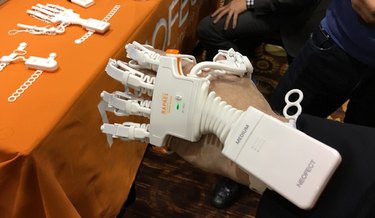
The Smart Glove itself resembles less a glove than a human hand. Made of an elastomer material it straps to your hand and contains sensors to measure force and various motions. A bending sensor can measure individual finger movements and "yield over 5,900 data points per minute," Neofect, the company that makes the Rapael Smart Glove, says.
The games used with the Smart Glove are designed for both efficacy and fun. Many have a direct real-world correlation because, after all, the goal is to help someone recover from a stroke or traumatic injury to perform basic functions around the house. There are games that have the patient practice pouring wine, wiping a table, squeezing a fruit and lifting a frying pan, among others.
What's measured is how well you can bend your wrist, or how much force you can squeeze your hand. Through repetition your ability to do these basic actions improves. Over time you regain your movement. The patient can see his or her performance results, which includes their current status, progress and improvement.
Neofect leases its gloves together with a tablet. Visit their site for more details.
ReSound ENZO2
The ReSound ENZO2 is an over-the ear hearing aid that streams audio directly from the iPhone, iPad, Apple Watch and other iOS devices.
Most hearing aids require a large dongle to connect to electronic devices like phones and tablets. These are hung over the neck or clipped to the shirt; they're hardly convenient. The ReSound ENZO2 does away with the need for such a dongle, as it connects wirelessly like a standard Bluetooth device.
The ReSound ENZO2 also features an app designed to deliver a better, customized listening experience. You can control volume, bass and treble, wind noise, filtering, and microphone directionality. It even has a tracking feature in which it locates your misplaced hearing aid, provided it's still connected to the device. (Losing a hearing aid is more common than you think, so many people will welcome this feature.)
The hearing aid also works with Android and other non-iOS devices, but that requires the use of the company's Phone Clip+, which is a wired dongle. Of course, this eliminates one of the biggest advantages of combining the ReSound ENZO2 with an iPhone.
EyeMobile Mini
The EyeMobile Mini is designed to allow people who can't use their hands to still use a computer. It gives you the power to control everything on your tablet or PC simply by moving your eyes.
The device itself is an eye tracker that sits under your tablet. It plugs into your tablet via a USB cable and does all the processing itself (so it's not making demands on your computer). All the gestures that you would ordinarily need to control your tablet or PC are translated into eye movements.
The EyeMobile Mini works with Window 7, 8 or 10. The company recommends certain tablets over others, these include, first and foremost, the Dell Latitude 10, which is its "certified" tablet. However, it also recommends the Microsoft Surface Pro, Lenovo ThinkPad Tablet 2, and Samsung ATIV Smart PC 500T.
The device comes with a foldable table stand for tabletop use and a mounting plate so it can be attached to a wheelchair. It retails for $2,350.
Open Sesame
Open Sesame is an Android smartphone that requires no touch interaction. Instead of hands, Open Sesame is controlled using a combination of head movements and voice commands. The project was started by CEO Oded Ben-Dov and Giora Livne, a former Israeli naval commander who suffered an accident and became a quadriplegic.
Open Sesame is intended to work intuitively. To open the smartphone you say "Open Sesame." The phone turns on and the front-facing camera tracks your head. As you move your head, a cursor moves on-screen. It responds to even slight head movements. When you hover on a place of interest, for example Gmail, options will open that allow you to enter the app. To turn off the phone after you're done, you say, "Sesame close phone."
Open Sesame has caught the attention of Google and the start-up is participating in a $1 million project funded by that tech company.
The Open Sesame smartphone retails for $1,200.
LumiWave
Suffering from joint and muscle pain? The LumiWave Infrared Light Therapy Device may be for you. It uses low-level infrared light to relieve pain. It works by penetrating deeply into tissue, stimulating the body to repair itself while reducing pain. The device includes four pods with 200 infrared LED emitters and a strap to attach them to your arm or leg. A controller lets you select the duration of your treatment, either 20 minutes or 30 minutes.
LumiWave is the first FDA approved device in its category. However, light treatment has been used since the 1960s. It's been shown that infrared light acts on nerve fibers to slow pain signals. Light also releases nitric acid. This has been found to initiate positive reactions in the body like decreasing inflammation, reducing pain and improving blood flow.
LumiWave boasts a slew of testimonials on its site from people who've used its device, from individuals to athletes to military trainers and physiotherapists. A former physician for the US Navy SEALS said, "I have had excellent personal success with the LumiWave in relieving back pain."
The LumiWave retails for $450. A LumiWave Double is also available that contains 8 pods. That retails for $580.
EyeQue
Do you worry about the condition of your eyes? Ever wish you could test them between eye doctor appointments? Most of the time, health care plans pay for one visit a year. But eyes can change faster than that. It would be nice to have a fast, accurate, inexpensive way to test them when we wanted. Enter EyeQue.
EyeQue is an affordable way to test your eyes whenever you want. And we do mean affordable. The EyeQue Miniscope only costs $30. It's simple to use. You attach it to your smartphone, launch the app and take some pixel-powered tests. At the end you get your eyeglass numbers -- spherical, cylindrical and axis figures – exactly what your doctor uses to write a prescription.
You can keep track of your vision history online as data is stored in the cloud. You can also order new lenses online. Eye doctors watch out. This little device means competition.
The EyeQue Miniscope only works with about two dozen smartphones, so check the list before you buy. The device won an Innovation Award at CES 2017.
2Breathe Sleep Inducer
If you need help falling asleep, the 2Breathe Sleep Inducer is a new device that could help. It came about serendipitously out of the company's original invention, a device designed to reduce blood pressure naturally without drugs. When 90 percent of users reported back saying it also helped them sleep better, the company realized it was on to something.
The 2Breathe Sleep Inducer includes a sensor that you wear around your torso with an elastic strap. It works together with an app that measures your breathing. Put on the sensor before sleep and it syncs with the app. The app plays hypnotic, soothing tones in step with your breathing patterns. When you start to fall sleep, your breathing pattern changes and 2Breathe recognizes it, changing over to passive tones. After a few minutes of sleep, the app turns off. When you wake in the morning, you're treated to a report with sleep statistics.
The 2Breathe Sleep Inducer costs $180 and comes with a 60-day money back guarantee. The device won an Innovation Award at CES 2017.
